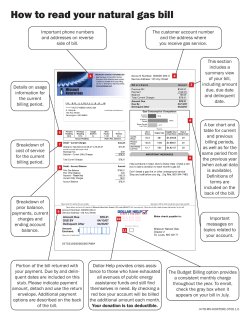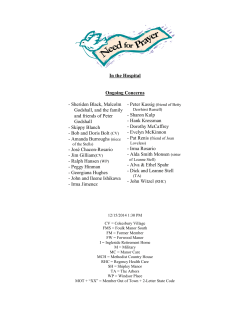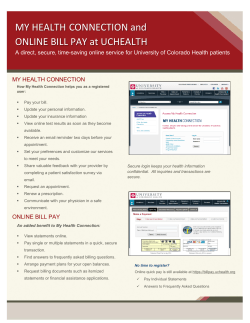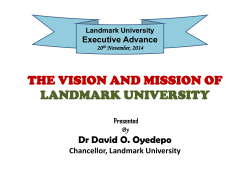
NARHC FALL INSTITUTE
NARHC FALL INSTITUTE Located in Landmark BR 4-7 unless noted otherwise 2015 TUESDAY, OCTOBER 27, 2015 7:30 – 8:30 am 8:00 – 5:00 pm Breakouts: U choose 8:30 – 9:25 am 9:30 – 10:30 am Breakfast (on your own) Registration CONFERENCE VENDORS: Tues. & Wed. only (Landmark BR 1-3) Landmark Ballroom 4-7 Majestic Ballroom B-C Starting a New RHC – Robin VeltKamp Maximizing Front End Collections – Marty Bennett • Learning timelines/documentation • Learn the importance of preparing for full compliance for survey certification & recertification • Develop, maintain, conduct a yearly review • Opportunities for RHC Funding Survey & Certification (panel) • Learn the value of policy writing, to support successful patient collections • Workflow evaluation and modification • Staff education and engagement The two Deeming Entities (AAAASF & The Compliance Team) as well as the Missouri Dept. of Health will talk about their respective approaches to RHC survey, certification, timelines, as well as address your questions. William will discuss the top 10 deficiencies in the RHC in Missouri. CHOWs occur for many reasons. Maintaining current status (PB or IND) is often preferred to avoid recertification as a new RHC. Changing status has separate requirements but can be obtained in conjunction with a CHOW. • Key business reasons for hosp/phys integration • RHC reimbursement implications • Conversion of RHC provider number Wm Nugent, AAAASF, & Kate Hill RHC Change of Ownership Status/CHOWs – Jeff Bramschreiber 10:30 – 11:00 am 11:00 – 11:45 am Networking Break (Landmark BR 1-3) RHC Billing: 101 – 7 Provider Based Requirements – Charles James, Jr 11:50 – 1:00 pm 1:00 – 1:55 pm Lunch - provided (Crystal BR) RHC Billing: Advanced – Task Management – Sarah Badahman Cost Reports: 101 – Julie Quinn & David James Telehealth – Tracey Burke 2:00 – 2:45 pm • Learn billing basics including acronyms • Learn the background & building blocks • Learn the difference between Medicare & Medicaid • • • • • Billing procedures for various types of rev codes Changes in RHC regulations that will impact billing Preventive Services, Non-RHC Services, Carve Outs Incident To Mental Health Billing • What you need to complete the report • Where it’s located on the report • Common Cost Report Calculations 2:45 – 3:15 pm 3:15 – 4:10 pm Networking Break (Landmark BR 1-3) Cost Reports: Advanced – Julie Quinn & David James 4:15 – 5:00 pm (Landmark BR 1-3) MAC Discussions: WPS 5:00 – 6:00 pm • • • • How/when to report Non-RHC hours/Commingling Rules Proper cost classification for rate maximization Methods for calculating lab/X-ray/EKG reclassifications Interest income, Medicare depreciation, Imputed compensation for Sole Prop/Partnerships • Related Party Transactions FTE Calculations, Overhead • Vaccine ratio calculations, data entry elements for B-1 PS&R crosswalk, Bad Debt overview, Sequestration • • • • Licensure Clinical Services Financial Integration Public Awareness Joint Ventures Obligations of hospital outpatient depts. Requirements for Off-site locations • • • • • Bringing life to policies and procedures Identify procedures that are action items Create and delegate tasks appropriately Log the who, how, when of task completion Evaluation of policy procedure effectiveness – task management/evaluation a key component • Creating a culture of documentation to comply with policies/procedures adopted by the organization With US healthcare transitioning from a volume to value model, it is a critical time for health care providers to reevaluate & evolve their services to meet new model quotas. Some healthcare providers must improve quality of care & reduce readmission rates, or face penalties. Others want to keep abreast of new technologies to compete & satisfy the demands of their market. See how one organization is incorporating TeleHealth into its RHCs. Small Practice Management – Elsie Crawford • • • • • • • Patient Centered Care Access & Communication Education of Patients Care Management Adoption & Use of Technology Teamwork Challenges (Majestic BR B-C) MAC Discussions: Novitas (Majestic BR A) MAC Discussions: Cahaba • Top 10 billing errors, denials & rejections Proper process to receive reimbursements Learn who to contact Reception (Hors d’oerves & beverages) (Washington) Located in Landmark BR 4-7 unless noted otherwise NARHC FALL INSTITUTE 2015 WEDNESDAY, OCTOBER 28, 2015 8:00 – 8:30 am 8:00 – 5:00 pm 8:30 – 10:00 am 10:00 – 10:30 am 10:30 – 11:30 am Breakfast (on your own) Registration (for any who didn’t register Wed.) CONFERENCE VENDORS: Tues. & Wed. only (Landmark BR 1-3) Legislative Update – Bill Finerfrock (Landmark BR 4-7) • Learn about the latest rules & regulations coming out of Washington. • Learn about possible changes likely to happen in the future. • Learn how the Affordable Care Act continues to affected RHCs Networking Break (Landmark BR 1-3) Annual Meeting – All conference attendees should attend (members and non-members)! Ron Nelson Award Elections Past year accomplishments Goals for 2016 Financial Report 11:30 – 1:00 pm Lunch (on your own) There are multiple restaurants within walking distance. 1:00 – 2:30 pm ICD-10 Beyond Implementation: Now What? – Gary Lucas 2:30 – 3:00 pm 3:00 – 4:15 pm Networking Break (Landmark BR 1-3) Annual Evaluation & Peer Review, Going Beyond the Requirements – Glen Beussink 8:30 – 9:45 am Breakfast (on your own) Meaningful Use: Overcoming Stumbling Blocks – Nadine Robin (Landmark BR 4-7) 9:45 – 10:45 am HIPAA Hazards and How to Avoid Them – Margaret C. Scavotto • • • • Top documentation challenges and major changes Gaining physician buy-in and cooperation ICD-10’s integration into coding & billing processes to maximize compliant revenue and reduce receivables Learn how to build, maintain, & manage Clinical Documentation Awareness teams Review of key elements of the Official Guidelines for Coding and Reporting Overview of the CFR 491.11 Regulations & going beyond the requirement. The Annual Evaluation basics will be covered & why you should include peer review. How and why we facilitate added review of financials, cost reports, charge master. How we have been able to find improvement in revenue through this process, compliance to Chapter 13 benefits manual as an audit tools for future audits, especially for PB. The Annual Evaluation is required. Why so many don’t perform it or don’t use this tool, is because it’s not viewed as a real investment. THURSDAY, OCTOBER 29, 2015 10:45 – 11:15 am 11:15 – 12:00 pm This presentation will provide participants with resources, tools, guidance, and the practical examples to continue on a successful path towards achieving Meaningful Use initiatives throughout Stage 1 (if stuck), Stage 2, and beyond to 3. The Office of Civil Rights, which enforces HIPAA, has said that “the gloves are off” when it comes to 6- and 7-figure HIPAA enforcement and penalties. That’s a big financial threat to providers, especially when considering that most HIPAA violations involve inadvertent conduct, often due to one employee mistake. To make matters worse, HIPAA penalties are just the tip of the iceberg when it comes to the costs of mitigating a data breach. • Are your employees tweeting their way to a HIPAA violation? • Will the government go easy on us if we are “working on” HIPAA compliance? • If we have a HIPAA violation, what are the hidden costs we can expect to pay? • What can we do to stay out of hot water? Networking Break (Landmark BR 1-3) Updates to Shortage Areas (HSPA/MUA/MUP) – HRSA • Attendees will learn the difference between the Data Release Date, the Date of Designation, and Designation Update. • Attendees will find MUAs, which often have a 1978 Date of Designation, but no Update, will not work for a new RHC • Attendees will learn that HPSAs have been “frozen” since Jan. 1 and why
© Copyright 2025









